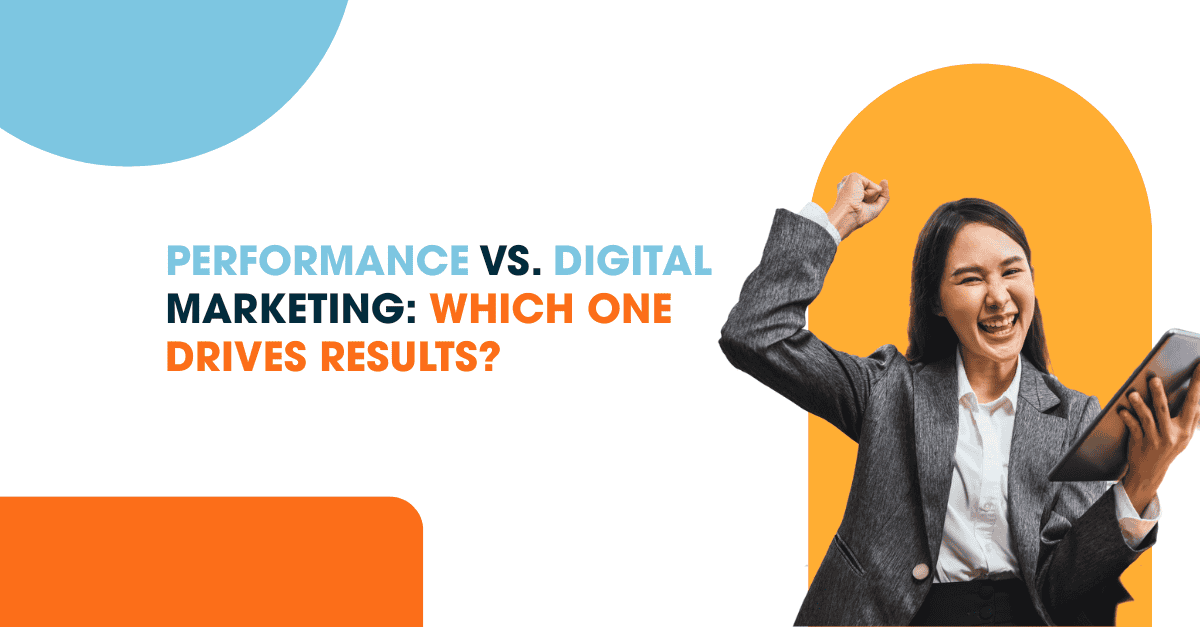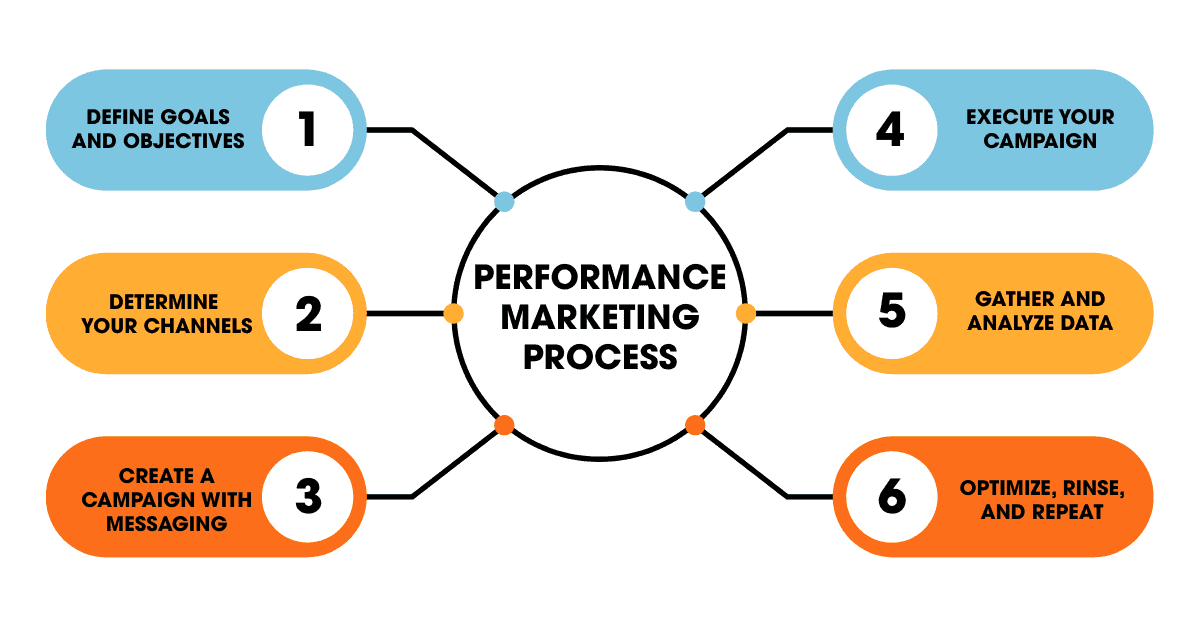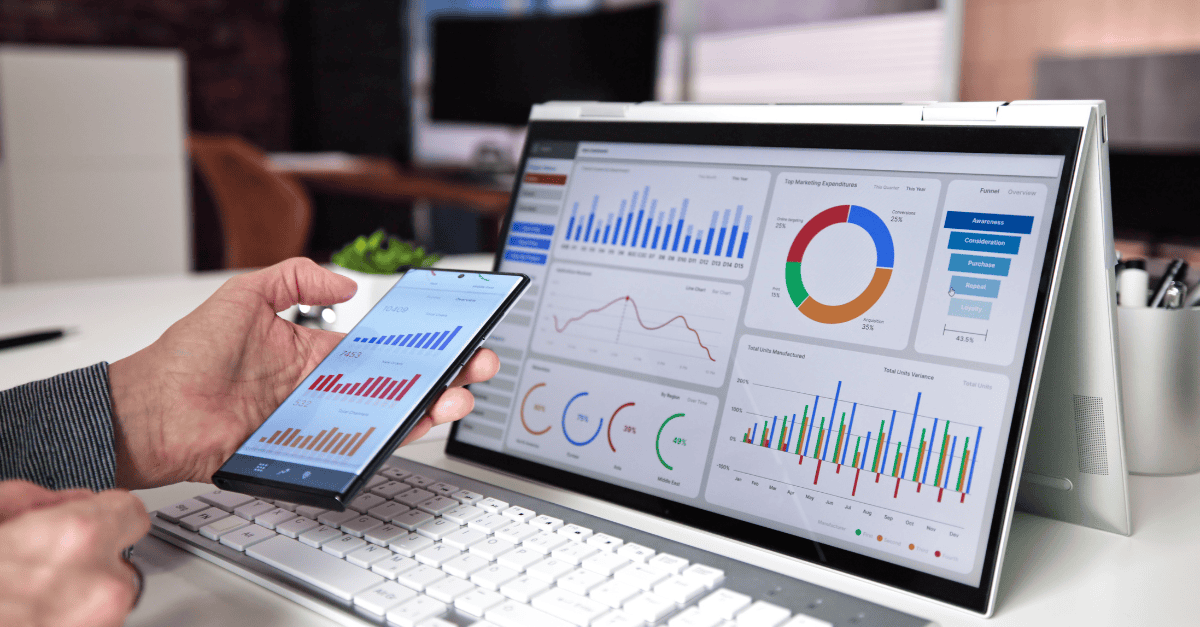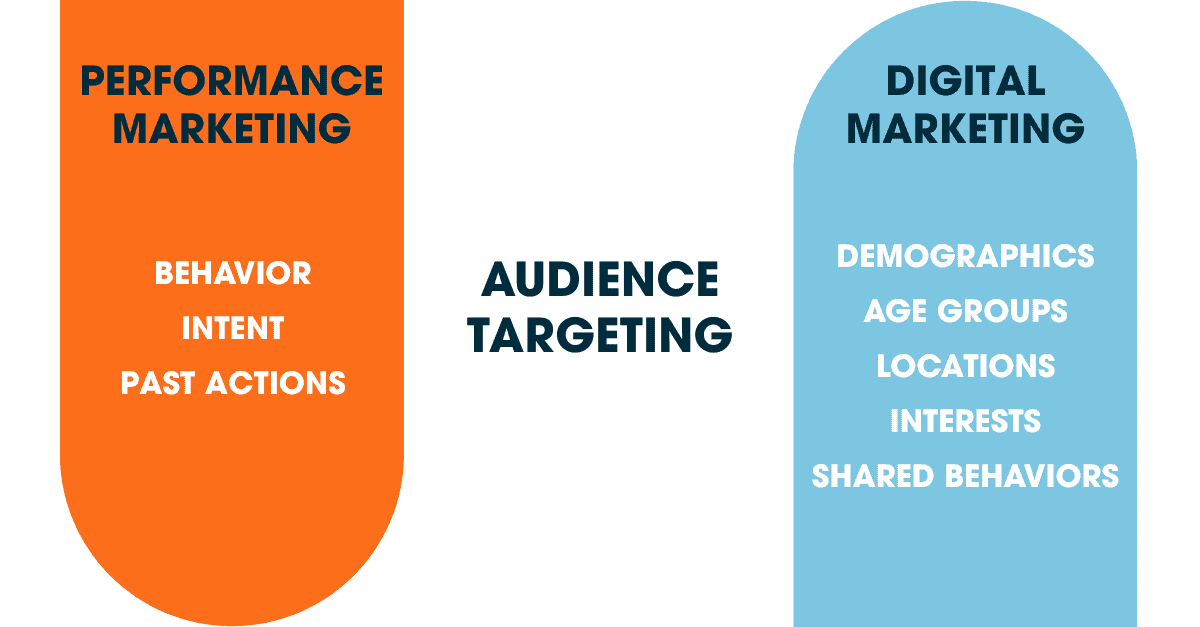
Performance Marketing vs Digital Marketing: Which One Drives Results?
Digital marketing casts a wide net. It covers everything from social media marketing and email campaigns to search engine optimization and content development. But within this broader range lies a more targeted, performance-driven approach—performance marketing.
The terms often get used interchangeably, which leads to confusion. But recognizing the key differences between digital marketing vs performance marketing can shape how you spend your budget, structure your marketing strategy, and reach the right target audience.
With global digital ad spend projected to hit over $765 billion in 2025, success depends on more than visibility. It requires measurable outcomes and a strategy built for adaptability.
This article breaks down what each approach involves, where they overlap, and how to choose the right fit based on your goals and growth stage.
Table of Contents
- What Is Digital Marketing?
- What Is Performance Marketing?
- Performance Marketing vs Digital Marketing: 7 Key Differences
- Goal and Focus
- Payment Structure
- Measurement and KPIs
- Time Horizon and ROI Expectations
- Optimization Approach
- Audience Targeting and Personalization
- Channel and Strategy Usage
- When to Use Digital Marketing
- When to Use Performance Marketing
- Why Performance Marketing Is the Future of Scalable Growth
- FAQs
- Conclusion
Key Takeaways
- Digital marketing is broad, focusing on long-term brand growth, awareness, and nurturing customer relationships.
- Performance marketing is outcome-driven, where advertisers only pay when specific actions (clicks, leads, sales) occur.
- Digital marketing metrics often include reach, impressions, engagement, and visibility, while performance marketing is measured with CPA, ROAS, CTR, and conversions.
- Digital marketing builds momentum over months, while performance marketing delivers fast, trackable results.
- The best strategies often combine both approaches — digital marketing for trust and brand presence, performance marketing for scalable ROI.
What Is Digital Marketing?
Digital marketing is a broad strategy that connects businesses with their target audience through digital channels. It encompasses everything from search engine optimization (SEO) and content marketing to social media advertising, email marketing, and pay-per-click (PPC) advertising.
Any form of promotion happening online—whether organic or paid—falls under this umbrella.
What sets digital marketing apart is its focus on long-term brand growth.
It’s designed to build brand awareness, increase engagement, and nurture potential customers over time. While direct sales and conversions are important, success here often hinges on visibility, reach, and interaction.
Metrics like impressions, social media post engagement, and time on site often take center stage when seeking measurable results.
The power of digital marketing lies in its mix of channels. Organic strategies like SEO and social media marketing help maintain a strong online presence, while owned media like email lists and websites create direct lines to your audience.
Paid options—including display advertising, Linkedin ads, and Search Engine Marketing (SEM)—offer immediate exposure and control over targeting.
Because digital marketing encompasses such a wide range of tactics, results may not always show up as instant conversions.
Instead, it supports brand recognition, fostering brand loyalty, and guiding users through the entire customer journey—from discovery to decision.
What Is Performance Marketing?
Not all marketing is paid up front.
In performance marketing, you only spend when the results show up—whether that’s a click, a lead, an app install, or a sale. It’s a sharp contrast to traditional methods, where you pay for exposure regardless of outcome.
Often called results-based marketing, this approach gives you full control over what you’re paying for and how you define success.
It’s common in affiliate marketing, cost-per-acquisition (CPA) campaigns, pay per click advertising, and even influencer partnerships that reward performance, not just reach.
What makes performance marketing stand out is its precision.
Every campaign is powered by data tracking, fine-tuned with performance metrics like CPA, click-through rate (CTR), and return on ad spend (ROAS). This is where performance marketers thrive—adjusting campaigns in real-time, using analytics to drive efficiency, and pursuing measurable results over vague impressions.
If your focus is fast growth, clear ROI, and performance-based marketing that can scale without wasted spend, this strategy hits the mark.
It’s about outcomes, not just activity—making every dollar accountable and every campaign goal-oriented. To see how that accountability takes shape, let’s break down what a typical performance marketing process actually looks like.

Performance Marketing vs Digital Marketing: 7 Key Differences
1. Goal and Focus
Think of digital marketing as the marathon runner—steady, strategic, and focused on endurance.
Its primary goal? Build brand awareness, nurture customer relationships, and foster long-term brand loyalty. Whether through content marketing, social media posts, or email marketing, the focus is often on visibility and connection rather than instant returns.
On the flip side, performance marketing is the sprinter.
It’s designed for speed, precision, and measurable outcomes. Every action—click, download, lead, or purchase—is tracked, analyzed, and optimized. With a pay for performance model, advertisers only spend when specific goals are met, making it ideal for short-term wins and direct sales.
For example, a digital marketing campaign might aim to grow your brand’s Instagram presence by publishing high-value social media content over several months.
Meanwhile, a performance marketing campaign could run social media ads targeted at driving immediate purchases from a seasonal sale—converting traffic into revenue fast.
Understanding the key differences in focus helps you choose the right approach: one builds the brand, and the other drives conversions.
2. Payment Structure
Where your money goes—and how it works for you—can define the success of your entire marketing strategy.
In digital marketing, payment often comes first, performance second. You’ll invest in content creation, SEO, social media marketing, and email campaigns upfront, with returns building gradually through improved brand exposure, trust, and engagement.
These efforts are essential for long-term brand loyalty, but they don’t always deliver tangible results right away.
Now contrast that with performance marketing, where you’re not paying for effort—you’re paying for outcomes.
Whether it’s cost per acquisition, click-throughs, or completed lead generation forms, every dollar is tied directly to a user action. This pay-for-performance model makes it easier to track ROI and prevents the budget from being eaten up by guesswork.
For instance, while a digital marketing agency might charge a fixed monthly fee to manage your content and build brand recognition, a performance marketer running a Google Ads campaign will charge you only when someone actually clicks or converts.
The difference? One charge for effort, the other for results.
For growth-focused brands, this structure offers more than efficiency—it provides clarity, control, and a lower-risk path to business success.
3. Measurement and KPIs

Not all numbers tell the same story. Just because a campaign reaches thousands doesn’t mean it’s driving sales. That’s where the contrast between digital marketing and performance marketing becomes especially clear.
In traditional digital marketing, success is often measured by visibility—reach, impressions, bounce rate, or post engagement.
These performance metrics help assess brand exposure and audience engagement, but they don’t always connect directly to conversions or revenue. You might be building a strong online presence but without a clear path to ROI.
Performance marketing, on the other hand, is built on precision.
Every campaign is tracked against hard numbers: CPA (cost per acquisition), CTR (click-through rate), ROAS (return on ad spend), and conversion rate. These key performance indicators provide immediate feedback on what’s working and what needs adjusting.
That’s why performance marketing campaigns are so agile—continuous optimization is baked into the strategy.
For example, if you’re running a search engine marketing (SEM) ad through Google Ads, you’ll know exactly how much you spent per conversion and what that return looked like.
With digital marketing, you might know how many people saw the ad—but not how many were truly moved to act.
Ultimately, the right KPIs don’t just report on activity—they inform decisions and drive profitable growth.
4. Time Horizon and ROI Expectations
If you’re playing the long game, digital marketing delivers. Strategies such as search engine optimization, content marketing, and social media marketing gain traction over time.
They’re designed to grow brand recognition, attract steady website traffic, and strengthen customer relationships. But that momentum often takes months to convert into revenue—and even longer to show significant ROI.
Meanwhile, performance marketing moves fast.
It’s built for speed, measurable growth, and campaign decisions backed by real-time data. Whether you’re promoting a limited-time offer or launching a new product, performance marketing channels let you test, adjust, and scale quickly.
The focus stays on short-term wins—driven by metrics like Cost Per Acquisition (CPA) and Return on Ad Spend (ROAS).
For example, a digital marketing strategy might involve six months of blog publishing and social media engagement to raise awareness.
In contrast, a performance marketing campaign could deliver direct sales within days through a well-targeted social media ad or pay per click advertising effort.
The difference is clear: one builds a brand over time through various online strategies; the other delivers tangible results fast—and gives you the data to back every decision.
5. Optimization Approach
How often you tweak a campaign can reveal a lot about the mindset behind it. In digital marketing, optimization is often paced—monthly or even quarterly.
Changes are based on broader trends in content performance, social media engagement, or website behavior. The approach is steady and strategic, built around long-term goals like growing brand loyalty and increasing lifetime value.
But in performance marketing, waiting weeks to make changes isn’t an option.
With every click and conversion tracking in real-time, optimization happens on the fly. Campaigns are constantly refined based on the data, adjusting targeting, creative assets, bidding strategies, and even channel selection across digital platforms.
It’s not about guessing what might work; it’s about reacting to what is working.
For example, if a performance marketing campaign running across social media platforms shows that LinkedIn ads are outperforming display advertising, a performance marketer will shift spend immediately to maximize ROI.
That’s the power of continuous optimization in action.
6. Audience Targeting and Personalization

Getting your message in front of the right person isn’t enough—it has to feel like it was made for them. That’s where the difference in targeting between digital marketing vs performance marketing becomes crystal clear.
In digital marketing, targeting often revolves around broader demographics or general interests.
Think age groups, locations, or shared behaviors. This approach works well for building a strong online presence, especially across social media platforms where mass visibility supports brand building.
But performance marketing takes it several steps further. Here, targeting is granular.
It’s not just reaching potential customers—you’re segmenting them based on behavior, intent, funnel stage, or past actions. Techniques like retargeting, behavioral triggers, and custom creative variations allow you to tailor offers to each group with razor-sharp accuracy.
And it pays off.
According to Epsilon, 80% of consumers are more likely to buy when they receive personalized content. That’s exactly why performance marketers lean into this strategy—because personalization drives measurable outcomes.
This is especially powerful in affiliate marketing and influencer campaigns, where personalized landing pages and product recommendations are tailored to each audience segment. It’s not just targeting—it’s connecting.
7. Channel and Strategy Usage
The best marketing strategy isn’t just about where you show up—it’s about why.
Both digital marketing and performance marketing use a variety of channels, but how they use them—and what they expect in return—looks very different.
In digital marketing, the goal is broad coverage.
You’re tapping into organic traffic through search engine optimization, nurturing relationships through email marketing, sharing content across social media, and investing in PPC to stay visible. The focus is to create a comprehensive marketing strategy that builds trust, nurtures leads, and fuels brand loyalty over time.
Performance marketing, by contrast, is less about presence and more about pressure—specifically, the pressure to perform.
It leans heavily on paid channels like affiliate networks, native advertising, influencer partnerships, and search engine marketing (SEM). Every channel is evaluated by its ability to deliver measurable results—whether it’s clicks, conversions, or direct sales.
While performance marketing focuses on ROI, it doesn’t discriminate by platform. It’s entirely channel-agnostic.
Whether the traffic comes from social media ads, Google Ads, or a high-converting display advertising slot, what matters is that it delivers.
Here’s a quick side-by-side to bring it all together:
Performance Marketing vs Digital Marketing: Key Differences
| Aspect | Digital Marketing | Performance Marketing |
|---|---|---|
| Goal | Brand awareness, trust-building, customer relationships | Measurable outcomes, direct actions like clicks or sales |
| Payment Model | Upfront costs, regardless of results | Pay-for-performance only after an action is completed |
| KPIs | Reach, impressions, engagement | CPA, ROAS, CTR, conversion rate |
| Time Horizon | Long-term, compounding returns | Short-term, fast-paced with scalable returns |
| Optimization | Monthly or quarterly based on trends | Real-time, data-driven continuous optimization |
| Targeting | Broad demographic or interest-based | Hyper-targeted, segmented, personalized content |
| Channels | SEO, content, social media, email marketing, PPC | Paid search, affiliate marketing, native ads, influencer marketing |
When to Use Each Approach?
Choosing between performance marketing vs digital marketing isn’t about which is better—it’s about which is better for your goals. Depending on your business stage, audience, and objectives, one approach may serve you more effectively than the other.
When Digital Marketing Makes Sense?
If your priority is shaping perception, building visibility, and earning loyalty over time, digital marketing delivers exactly that. It’s the go-to strategy for businesses that want to create a recognizable presence across digital channels and nurture leads from awareness to action.
Research shows that digital ads can increase brand awareness by 80%, making them a powerful tool for creating visibility in crowded markets.
With a mix of social media marketing, email campaigns, and content creation, digital marketing helps establish your voice and build emotional connection.
It’s also ideal for publishing evergreen content, improving search engine rankings, and laying down the SEO foundation for long-term success. Blog posts, guides, and optimized landing pages work silently in the background, attracting your target audience day after day.
If you’re focused on brand building, educating potential buyers, and turning curiosity into trust, digital marketing gives you the space—and tools—to do it right.
When Performance Marketing Is the Better Fit?
When time and budget are tight, you can’t afford to guess what’s working—you need proof. That’s where performance marketing becomes a powerful asset.
It’s built for businesses that need to generate results quickly, with every dollar tied directly to measurable outcomes.
If you’re launching a new product, running a seasonal campaign, or simply aiming for immediate ROI, performance marketing campaigns give you speed and control.
With pay per click advertising, affiliate partnerships, or social media ads, you can drive traffic and conversions fast—then scale what’s working in real time.
It’s also the better fit when you need to justify spend with hard data.
Metrics like Cost Per Acquisition (CPA), Return on Ad Spend (ROAS), and conversion rate allow you to evaluate performance, optimize efficiently, and prove impact. Whether you’re using search engine marketing (SEM) or display advertising, every channel is aligned with one goal: tangible results.
For brands focused on lead generation, customer acquisition, or getting the most out of a limited marketing budget, performance marketing doesn’t just deliver—it proves its worth at every step.
Why Performance Marketing Is the Future of Scalable Growth?
In today’s market, brands aren’t just chasing visibility—they’re chasing value. As ad costs rise and attention spans shrink, the demand for measurable results, scalable campaigns, and predictable ROI is stronger than ever. That’s exactly where performance marketing shines.
Thanks to tools like UTM tracking, attribution platforms, affiliate networks, and real-time analytics, marketers now have the power to optimize campaigns with speed and precision. It’s no longer about spending more—it’s about spending smarter.
At YepAds, performance isn’t just a goal—it’s the foundation. Whether you’re an advertiser looking to drive lead generation, or an affiliate focused on performance-based marketing, YepAds offers a full-service ecosystem designed for outcomes, not just activity. With deep channel expertise, transparent reporting, and access to global traffic sources, it’s built to deliver exactly what today’s growth-focused brands need.
Ready to stop guessing and start scaling? At Yep Ads, we don’t just talk performance—we deliver it. Ready to scale smarter? Visit yepads.com to get started.
FAQs About Performance Marketing
Is performance marketing worth it in 2025?
Yes—if you’re focused on results, performance marketing and digital marketing can work together effectively . Performance marketing ensures you only pay for specific actions like clicks, leads, or sales. It’s a budget-efficient strategy that reduces risk and delivers measurable outcomes. For brands looking to scale quickly and track ROI in real time, it’s a smart way to drive growth without wasting spend.
Is performance marketing a SEO?
No, SEO (Search Engine Optimization) is a part of digital marketing, not performance marketing. While SEO improves organic visibility over time, performance marketing focuses on paid strategies that drive immediate actions. However, both can work together—SEO builds long-term brand trust, while performance campaigns generate faster, trackable results.
Is performance marketing the same as paid marketing?
Not exactly. While all performance marketing is paid, not all paid marketing qualifies as performance-based. Traditional paid ads may focus on reach or impressions, but performance marketing channels are strictly tied to actions like conversions or clicks. The difference lies in how you pay—and what you’re paying for.
What is the difference between a digital marketer and a performance marketer?
A digital marketer focuses on broader goals like brand building, engagement, and long-term growth using various digital platforms. A performance marketer, on the other hand, is results-driven—focused on conversion rates, CPA, and ROAS. Their job is to optimize for actions that directly impact revenue, often using real-time data and rapid testing.
If you enjoyed this post, you might also like these articles we picked for you:
- Affiliate Agencies vs. Going Direct: Which Is Better?
- Why Your Brand Should Embrace Affiliate Marketing
- What Is Affiliate Marketing? A 2025 Full Guide

Join as an Advertiser
Join as a Publisher
